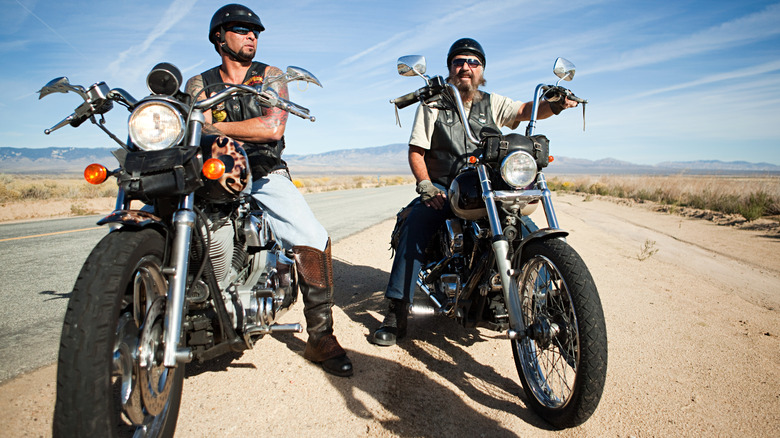How California Became The Nation's Leader In Biker Gangs
An early 1990s report from the California Department of Justice noted that there were more than 500 U.S.-based motorcycle gangs at the time, many with evocative names like Iron Horsemen, Rebel Rousers, and Grim Reapers. If you haven't heard of these clubs then maybe Hells Angels, Pagans, Bandidos, or Outlaws ring a bell. These gangs make up the "Big Four" and like many other biker clubs have a strong presence in California. For example, the Hells Angels were founded in Fontana and maintain a west coast headquarters in Oakland. The state's post-World War II population boom and favorable weather helped make motorcycling especially popular there, but an annual gathering that began in 1947 in the small central coast town of Hollister has also attracted thousands more bikers to the state.
Biker clubs in the U.S. have roots going back more than 100 years; Harley-Davidson and Indian Motorcycles were founded in the first few years of the 20th century and motorcycles caught on quickly in the United States. Indian co-founder George Hendee was part of a small group that organized the Federation of American Motorcyclists (FAM) in September of 1903; the club grew rapidly and was reorganized as the American Motorcycle Association (AMA) in 1924. Two decades later, many Americans got their first exposure to motorcycles while serving in World War II.
When the war ended in 1945, plenty of these bikes (many of them Harley-Davidsons) were sold as cheap surplus and found their way onto American roads. Many servicemen and women came back to the country via bases in California, and the post-war era was a boom time for the state. California's population more than doubled between 1940 and 1960, when the U.S. Census counted nearly 16 million California residents and motorcycles were everywhere.
Motorcycle clubs offered returning veterans a sense of community
Not all these new faces belonged to returning soldiers, but many veterans had steady pay to spend on a motorcycle for cruising in the California sun. Some veterans also embraced the sense of camaraderie they had known during the war and gave their clubs military-inspired nicknames. This includes the Hells Angels, who took that moniker from a famous B-17F heavy bomber that was part of the U.S. Air Force 303rd Bombardment Group. Outlaw motorcycle culture took hold in California after the AMA's Fourth of July 1947 tour, race, and rally event in the central coast town of Hollister. Bikers and hippies later became yin/yang halves of the '60s counterculture movement; both groups were drawn to California's laid-back reputation and beautiful weather. New clubs popped up around the state as more bikers came to spend a weekend in Hollister and later moved to California.
The first rally in 1947 helped establish outlaw motorcycle culture. Hollister's central location in the mountains east of Monterey Bay drew thousands of bikers — almost as many as lived in the small farm town — and Hollister's residents and 21 bars were soon overwhelmed by the rowdy bikers, some of whom rode their bikes into local businesses. Hollister police called in 40 California Highway Patrol officers on Sunday to help restore order, and many bikers were charged with misdemeanors like reckless driving and public intoxication. Although no serious violent or property crime was reported, newspaper reports with words like 'havoc' and 'riot' describing the event spread across the nation. Despite this, Hollister welcomed the AMA and local Salinas Ramblers club back a few months later, and the Fourth of July weekend rally was held annually for 70 years before before taking a break from 2018 through 2024.
California's motorcycle clubs have grown with the state
The 1947 Hollister rally inspired the 1953 film "The Wild One" starring Marlon Brando, and the movie contributed to the nationally held idea that bikers were dangerous hooligans. After the rally made news, the AMA argued that 99 percent of bikers were upright citizens and labeled outlaw biker gangs the "one percent." Many groups embraced this image, and "One Percenter" motorcycle clubs are still around today. The Hollister town website calls the 1947 event "the birth place of the American biker" and welcomes riders to take "some of the most breathtaking rides in California" in the nearby coastal mountains and redwoods.
These rides have drawn motorcyclists to California for decades, and clubs flourished in the state as its population grew to 39.5 million by 2020. Some motorcycle clubs are classified as criminal gangs by the Department of Justice, but many groups do positive work for communities in California. The Hope Motorcycle Rally in Lake Tahoe raised $100,000 for cancer research in 2024, and the Hells Angels and other motorcycle clubs hold annual holiday toy drives for families in need around the state.


